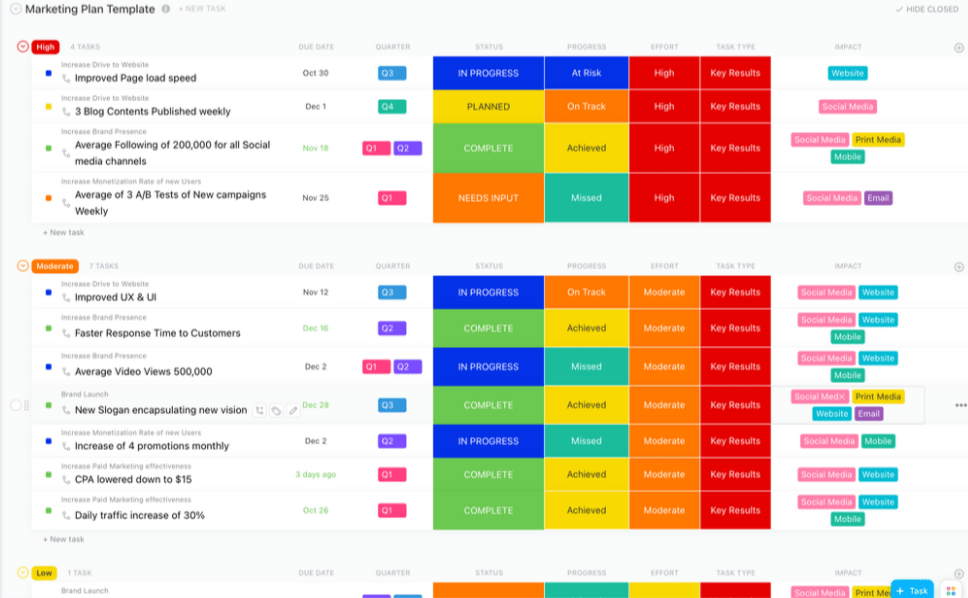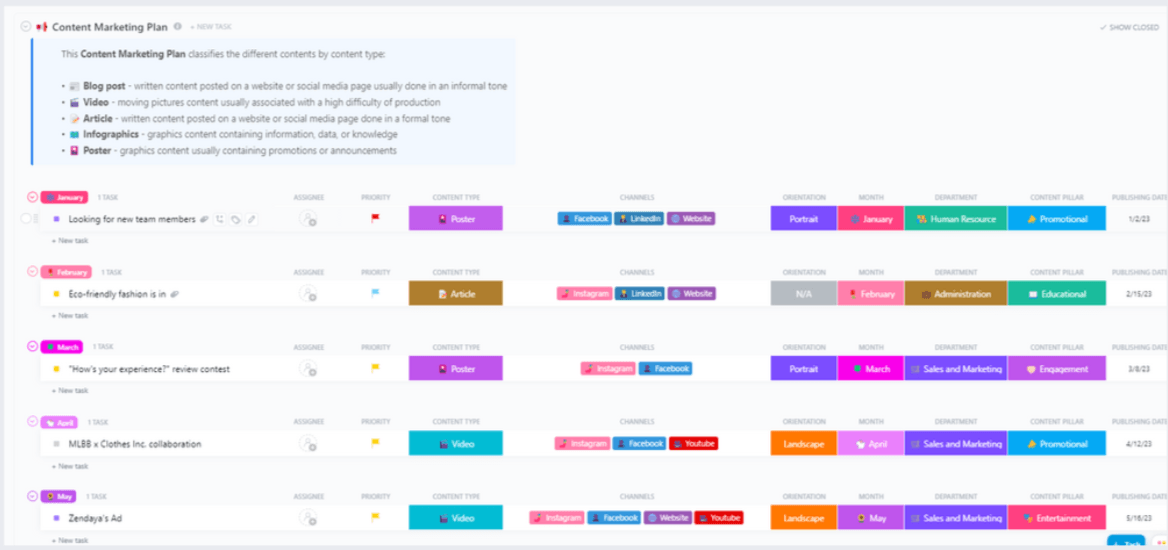خارطة طريق تسويقية لـ إدارة التسويق r هي بمثابة وصفة للطاهي - وهي ضرورية للغاية لتوضيح المكونات والخطوات اللازمة للنجاح.
ولكن ما الذي يترجم إلى نجاح التسويق؟
تحدد معظم الشركات نجاح التسويق من خلال النظر إلى نتائج مختلفة تمامًا. قد يتوقع البعض أن يحقق فريق التسويق نتائج الإيرادات أو مساعدة المبيعات على تحقيق الإيرادات أو النمو.
وفي الوقت نفسه، قد تنظر شركة أخرى إلى مقاييس مثل عدد زيارات الموقع الإلكتروني، والتفاعلات على وسائل التواصل الاجتماعي، والوعي بالعلامة التجارية، والعملاء المحتملين المؤهلين للتسويق، وما إلى ذلك.
تعمل خارطة الطريق التسويقية على إزالة الفجوة بين التفكير والعمل من خلال مساعدة المسوقين على تتبع التقدم المحرز. إنها تبسط الطريقة التي تعمل بها فرق التسويق. تساعد أعضاء الفريق على فهم ما هم مسؤولون عنه في السياق الأوسع.
استخدم هذا الدليل للاستفادة من خارطة طريق استراتيجية التسويق التي تتوافق مع الاستراتيجية السنوية لمؤسستك وأهداف العمل.
ما هي خارطة طريق التسويق؟
خارطة طريق التسويق هي وثيقة توضح بصريًا استراتيجيتك التسويقية - وكيف ستتطور مبادراتك التسويقية.
انظر إليها كجدول زمني لاستكمال الأهداف التسويقية . مثل أي خارطة طريق أخرى، يمكنك تضمين نقطة البداية (تاريخ البدء)، وعلامات الطريق (معالم المشروع)، ونقطة النهاية (الموعد النهائي).
فيما يتعلق بعملية التسويق، فإنك ترسم جميع جهودك التسويقية الرقمية مقابل إطار زمني محدد.
بعد ذلك، تشارك خارطة الطريق التسويقية هذه مع فريقك التنفيذي وفريق التسويق وأصحاب المصلحة الرئيسيين الآخرين للحصول على الملاحظات والتأييد والتوجيه بشأن مبادراتك التسويقية الاستراتيجية.
ما هي فوائد خارطة طريق التسويق؟
هل ترغب في إكمال مشروعك حسب المواصفات وفي الوقت المناسب وبما يتماشى مع أهداف شركتك؟
حاول إنشاء خارطة طريق للتسويق، والمعروفة أيضًا باسم خارطة طريق الاستراتيجية.
إن خارطة الطريق التسويقية - أو بتعبير الشخص العادي، خطة تسويقية - تجعل من السهل على فريق التسويق لديك معرفة
- ما هي الأنشطة التسويقية التي يجب القيام بها
- كيفية تحقيق أهداف التسويق
- موعد تقييم التقدم المحرز في المهام الحالية
وما إلى ذلك.
تشمل الفوائد الأخرى لخارطة طريق التسويق ما يلي:
- تصور كيفية إسهام كل مبادرة تسويقية في تحقيق أهداف الشركة الأوسع نطاقًا بحيث تركز جهودك على المقاييس الصحيحة
- توفر نظرة عامة واضحة على جميع الأنشطة التسويقية المخطط لها، مثل الحملات التسويقية وإنشاء المحتوى والفعاليات، وتوضح ما يجب القيام به ومتى يتم القيام به
- يساعد في وضع أهداف تسويقية محددة ورسم الخطوات اللازمة لتحقيقها، مما يسمح لك بقياس التقدم المحرز بفعالية وإجراء التعديلات
- يمكّن المديرين من تخصيص الموارد مثل الميزانية والوقت والقوى العاملة بحيث لا يفوت الأوان لمعالجة الاختناقات أوقيود الموارد
- يتضمن جداول زمنية ومراحل رئيسية لكل نشاط لإدارة المواعيد النهائية وإبقاء الفريق في الموعد المحدد
- يتيح تعاونًا سلسًا بين أعضاء الفريق وأصحاب المصلحة ويعزز الفهم المشترك لخطة التسويق
من يمكنه استخدام خارطة طريق التسويق؟
لا تقتصر خرائط طريق التسويق على مديري التسويق أو المديرين التنفيذيين فقط. والحقيقة هي أن أي محترف له دور في وضع الاستراتيجيات أو التخطيط أو التنفيذ أو تقييم الحملات التسويقية يمكن أن تستفيد من استخدام خارطة طريق تسويقية. إليك نظرة فاحصة
مدراء التسويق: هذا هو المستخدم الأكثر تقليدية لخارطة طريق التسويق. يمكن للمديرين استخدام خارطة الطريق لتحديد الأهداف وتتبع الجداول الزمنية وتخصيص الموارد ونقل التقدم الحالي إلى أصحاب المصلحة.
منشئو المحتوى: يمكن للكتاب ومصممي الجرافيك ومصوري الفيديو استخدام خارطة طريق التسويق لمواءمة عملهم مع خطة التسويق الأكبر، مما يضمن أن جهودهم الإبداعية تدعم الأهداف المحددة.
مدراء وسائل التواصل الاجتماعي: يتضمن الدور تنسيق العديد من الحملات عبر منصات متعددة. يمكن أن تساعد خارطة طريق التسويق هؤلاء المتخصصين في جدولة المحتوى وتتبع المشاركة وقياس نجاح الحملات المختلفة.
متخصصو تحسين محركات البحث: يمكنهم استخدام خارطة طريق لتحديد استراتيجيات الكلمات الرئيسية الخاصة بهم, تتبع أهداف تحسين محركات البحث وعرض النمو في تصنيفات البحث في الموقع بمرور الوقت.
محترفو العلاقات العامة: يمكن لخارطة طريق التسويق أن تساعد محترفي العلاقات العامة في جدولة النشرات الصحفية وتتبع التواصل مع وسائل الإعلام.
مديري المنتجات: بالنسبة لأولئك الذين هم على وشك إطلاق منتج أو ميزة جديدة، يمكن أن تكون خارطة طريق التسويق مفيدة في مواءمة جميع الفرق المشاركة في الإطلاق وتتبع المهام التي تؤدي إلى ذلك.
فرق المبيعات: يمكن لمحترفي المبيعات استخدام خرائط طريق التسويق لفهم الوقت المتوقع لوصول عملاء محتملين جدد من الحملات التسويقية، مما يسمح بتحسين عمليات التنقيب ومتابعة العملاء المحتملين.
في الأساس، يمكن لخارطة طريق تسويقية جيدة التنظيم أن تبسّط الإجراءات التشغيلية وتزيد من إنتاجية جميع الأدوار المرتبطة بجهود التسويق في الشركة.
## مكونات خارطة طريق التسويق
تبدو كل خارطة طريق للتسويق مختلفة - اعتمادًا على من يضعها. يستخدم مدير التسويق المكونات التي تناسبه على أفضل وجه أسلوب العمل لإنشاء قالب تسويقي مخصص لاحتياجاتهم.
ومع ذلك، تشترك خرائط طريق التسويق الناجحة في بعض المكونات المشتركة:
- الإطار الزمني: يتضمن تواريخ البدء والانتهاء لتوضيح موعد اكتمال الأنشطة التسويقية؛ استخدم مقياسًا زمنيًا مثل الأيام والأسابيع والأشهر وما إلى ذلك، لجعل خارطة طريق التسويق أكثر تحديدًا
- الأهداف: يشير إلى أهداف العمل القابلة للقياس والمحددة زمنيًا في شكل خارطة طريق تسويقية لتسليط الضوء على ما يجب تحقيقه إلى جانب مؤشرات الأداء الرئيسية للنجاح
- المبادرات: توفر التوجيه الاستراتيجي فيتخطيط المشروع ويسلط الضوء على مجالات التركيز الرئيسية لخرائط طريق التسويق الخاصة بك
- الجداول الزمنية: يقدم نظرة عامة مرئية لخارطة طريق الحملة التسويقية والجهد التعاوني لتوصيل ما يحدث في الوقت المناسب
- الأنشطة: يمثل المهام والمنجزات التي يجب أن تعمل عليها فرق التسويق والتطوير، مثل الصفحات المقصودة وإطلاق التطبيقات والإصدارات الصحفية وما إلى ذلك، لتسليط الضوء على الأنشطة التسويقية القادمة
- الحالة: تشير إلى الأهداف التسويقية والمبادرات التسويقية والخطط التسويقية وغيرها مقابل خارطة طريق المشروع
## أنواع خرائط طريق التسويق
1. خارطة طريق المحفظة: خارطة طريق المحفظة مفيدة لمديري التسويق الذين يديرون مشاريع مختلفة في وقت واحد. توفر خارطة الطريق هذه رؤية شاملة لجميع المبادرات أو المشاريع، وتوضح كيفية توافقها مع استراتيجية المؤسسة وأهدافها. وهي تساعد في إدارة الموارد عبر مختلف المشاريع، ومواءمة المواعيد النهائية، والحفاظ على تزامن جميع أصحاب المصلحة.
2. خارطة طريق الاستراتيجية: خارطة طريق الاستراتيجية هي تمثيل مرئي عالي المستوى لاستراتيجيتك التسويقية. وهي تصور أهداف التسويق الاستراتيجية وتسلط الضوء على المبادرات الرئيسية التي ستساعد في تحقيق تلك الأهداف. تعد خارطة الطريق هذه ممتازة لتوصيل الصورة الكبيرة واتجاه جهودك الإعلانية إلى أصحاب المصلحة.
3. خارطة طريق الأنشطة التسويقية: يتعلق هذا النوع من خرائط الطريق بالجانب التشغيلي لاستراتيجيتك التسويقية. فهي توضح بالتفصيل المهام والأنشطة المحددة التي سيقوم بها فريقك لتنفيذ استراتيجية التسويق. أشياء مثل إنشاء المحتوى والترويج، وحملات وسائل التواصل الاجتماعي، وتنظيم الفعاليات، والعلاقات العامة، وما إلى ذلك، يمكن رسمها جميعًا في جدول زمني محدد في خارطة طريق الأنشطة التسويقية.
4. خارطة طريق إطلاق المنتج: تُعد خارطة طريق إطلاق المنتج مثالية لتسويق المنتجات الجديدة، حيث تحدد خارطة طريق إطلاق المنتج جميع المهام والمواعيد النهائية والموارد اللازمة لتسويق منتج أو خدمة جديدة بنجاح. وهي تغطي كل شيء بدءًا من أبحاث السوق الأولية واستراتيجيات تحديد المواقع إلى الحملات الترويجية وتقييمات ما بعد الإطلاق.
5. خارطة طريق تسويق المحتوى : تركز خارطة الطريق هذه على إنشاء وتوزيع وتتبع المحتوى المصمم لجذب جمهور مستهدف محدد وإشراكه. وقد تتضمن منشورات المدونة ومقاطع الفيديو وحملات البريد الإلكتروني ومحتوى وسائل التواصل الاجتماعي، من بين أشكال أخرى. كما تحدد خارطة الطريق هذه عادةً من سيقوم بإنشاء المحتوى، ومتى سيتم نشره، والقنوات التي سيتم توزيعه من خلالها.
6. خارطة طريق التسويق لتحسين محركات البحث: تحدد خارطة طريق التسويق لتحسين محركات البحث الاستراتيجيات والمهام لتحسين ظهور الموقع الإلكتروني في تصنيفات محركات البحث. وقد تشمل البحث عن الكلمات الرئيسية، والتحسينات على الصفحة وخارجها، واستراتيجيات بناء الروابط، ومقاييس التتبع لتقييم الأداء. تُبقي خارطة الطريق هذه الجميع على نفس الصفحة حول أولويات وأهداف تحسين محركات البحث.
قوالب خارطة طريق التسويق
قد يبدو التنقل في التسويق في كثير من الأحيان رحلة معقدة. لحسن الحظ، لدينا قوالب يمكن أن تجعلها أقل صعوبة. تعمل هذه النماذج الجاهزة كخارطة طريق لرسم خريطة طريق لرسم رحلتك التسويقية، مما يوفر مسارًا واضحًا نحو أهدافك.
قالب ### قالب خطة خارطة طريق التسويق ClickUp للتسويق
حقق النجاح التسويقي دون عناء مع قالب خطة التسويق ClickUp للتسويق
انقر فوق خطة التسويق الاستراتيجي نموذج
استخدم قالب خطة التسويق الاستراتيجية من ClickUp لتخطيط أهداف قابلة للتنفيذ لفريقك
قالب خارطة طريق تسويق المحتوى من ClickUp
ارتق بمستوى تخطيط المحتوى الخاص بك مع قالب خطة تسويق المحتوى من ClickUp
كيفية إنشاء خارطة طريق للتسويق؟
تعرف على كيفية إنشاء خرائط طريق تسويقية لفريقك التنفيذي وأعضاء فريقك في غضون دقائق.
أولاً، تذكر أولاً أن خارطة طريق التسويق الخاصة بك قد تتخذ أشكالاً مختلفة - قائمة مرجعية للمهام، أو تقويم المحتوى أو لوحة كانبان أو مخطط جانت. بغض النظر عن التنسيق الذي اخترته، فإن إنشاء خرائط طريق تسويقية يتبع عملية محددة.
قم بإعداد واحدة باتباع الخطوات التالية:
الخطوة 1: التقييم على المستوى الأساسي
افهم ما تحتاج إلى التخطيط له أولاً. اسأل
- هل سأستخدم خارطة الطريق لمشروع مثل منشور مدونة واحد، أو إطلاق موقع إلكتروني، وما إلى ذلك؟
- هل سأستخدمها لحملة كاملة تضم العديد من المهام والأنشطة والمشاريع الفرعية؟
- هل سأستخدمها لتنظيم استراتيجيتي السنوية؟
الخطوة 2: ابدأ بالتفكير في الخطوات المتضمنة
حان وقت العصف الذهني وتقسيم المهام الأكبر إلى أجزاء أصغر وأكثر قابلية للتحقيق. اسأل:
- ما هي العناصر والمبادئ والمهام التي سأحتاج إلى تقسيمها إلى أجزاء أصغر؟
- ما هي الخطوات اللازمة لإكمال المخرجات؟
- ما هي المعايير التي يجب أن أستخدمها لتتبع التقدم المحرز؟
- ما المهام التي تتطلب المزيد من التنسيق لتنفيذها بسلاسة؟
الخطوة 3: البدء في الجداول الزمنية
الخطوة التالية هي إضافة جدول زمني لمبادراتك.
استخدم أياً من المقاييس التالية لإضافة عنصر زمني واقعي لأهدافك:
- يشير التقدير الثلاثي النقاط إلى متوسط تقديرك لوقت المشروع في أفضل الحالات ومتوسطها وأسوأها
- التقدير التصاعدي يتطلب منك الحصول على تقديرات الوقت من الفرق المعنية وجمعها معًا
- التقدير التناظري يعني تقدير وقت المشروع اعتمادًا على الوقت المستغرق في مشاريع مماثلة
- يشير التقدير البارامتري إلى بناء التقدير على التقارير الداخلية أو الخارجية بالإضافة إلى البيانات
الخطوة 4: قم بتعيين مشاريعك ومهامك في برنامج إدارة المشاريع المفضل لديك
إذا لم تكن قد اخترت بعد أداة لإدارة المشاريع، فإن ClickUp هو خيار جدير بالاهتمام. يوفر ClickUp جميع الميزات اللازمة لإنشاء خرائط طريق تسويقية قوية لحملة تسويقية متكاملة!
إليك بعض ميزات ClickUp التي ستعزز عملياتك التسويقية:
- يوفر ClickUp مساعدة مدعومة بالذكاء الاصطناعي: قد تستغرق كتابة وصياغة استراتيجيات ومهام التسويق وقتًا طويلاً. ClickUp Brain يمكن أن يساعدك في كتابة رسائل بريد إلكتروني ومدونات ومحتويات رقمية أخرى أسرع وأكثر فعالية تشكل جزءًا من خارطة طريقك التسويقية.
- تصور مع عرض مخطط جانت البياني: مععرض جانت الخاص بـ ClickUpيمكنك تصور معالم المشروع والمواعيد النهائية والعلاقات بين المهام والمعالم في خارطة طريق التسويق، مما يضمن عدم تفويت أي شيء.
- مشاركة المستندات التعاونية:مستندات ClickUp تتيح لك مشاركة المستندات المتعلقة بخارطة طريقك التسويقية والتعاون ودمجها بسهولة في سير عملك، مما يضمن أن يكون كل عضو في فريقك على نفس الصفحة.
- إعداد الهدف:أهداف ClickUp يساعدك على تحديد أهداف واضحة وقابلة للقياس وتتبع تقدمك نحوها تلقائيًا، مع التأكد من أن خارطة الطريق الخاصة بك تتماشى مع تحقيق أهدافك النهائية.
- إدارة المشاريع: سواء كنت تنشئ تقويمًا بسيطًا للمحتوى أو حملة تسويقية متكاملة ومعقدة، يوفر لك ClickUp الأدوات اللازمة لتخطيط مشاريعك ومهامك بفعالية وتتبع تقدمك، مما يزيد من كفاءة تنفيذ خارطة طريقك التسويقية.
ابدأ التخطيط باستخدام خرائط طريق التسويق
تجد معظم فرق التسويق نفسها غارقة في التعامل مع مشاريع متعددة في وقت واحد.
وقد يفشلون في مراعاة الاحتياجات الفورية للجمهور المستهدف. وقد يُجبرون على القفز على الجدول الزمني بسبب عدم كفاءة إدارة عبء العمل.
وقد يعرضون جهود المؤسسة بأكملها للخطر إذا أصبحت الموارد غير متوفرة فجأة. يزيل نموذج خارطة طريق التسويق الكثير من هذا الصداع.
إن إنشاء خرائط طريق للحملة هو أفضل طريقة لتحديد حملاتك التسويقية وإعادة ابتكارها. فهو يضيف المزيد من التنظيم إلى عملية التخطيط التسويقي . يساعدك إنشاء خارطة طريق منفصلة للمحفظة على متابعة المشروع بأكمله.
إذا لم تكن متأكدًا من كيفية ومكان البدء، فجرّب ClickUp قوالب خطة تسويق مجانية وتحسين مشاريعك التسويقية - من البداية. يجب أن تستفيد المبادرة التسويقية من نقاط القوة لدى الفرق متعددة الوظائف وتحقق مؤشرات الأداء الرئيسية لنجاح التسويق- ClickUp يساعدك على الوفاء بهذا الوعد لجميع المشاريع. جرّب العرض التوضيحي وشاهد بنفسك!




